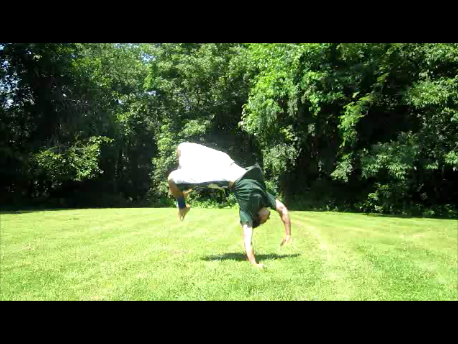Don’t lift that spoon! You just trained shoulders yesterday. Are you crazy? You know you can’t move a muscle for 48 hours after your training. Incubate! You’re a useless piece of slop until you recover! Grab the senzu beans! The secret to strength? Easy. Lift big weights. Eat a lot of food. Most importantly: don’t [...]

Don’t lift that spoon!
You just trained shoulders yesterday. Are you crazy? You know you can’t move a muscle for 48 hours after your training. Incubate! You’re a useless piece of slop until you recover!
Grab the senzu beans!
The secret to strength?
Easy. Lift big weights. Eat a lot of food. Most importantly: don’t compromise your recovery! Who has the energy to trick when the bar is waiting for you tomorrow? Or when the bar destroyed you yesterday?
And so the cycle begins. You want strength, so you pour yourself into the barbell. You don’t want to sacrifice your ability to gain strength, so you rest up in hopes of recovering in time for your next training session. Recreational activities fade. You are now a slave.
It was a cycle that I fell into — a cycle of avoiding anything that could compromise the pursuit of barbell strength. (Sad considering my ability never added up to my time investment.) You start to see the body in parts because it helps your body behave a bit more linearly. Makes strength gain easier. Train shoulders one day, avoid stressing them for the next few days. Next thing you know you are a compartmentalized freak.
Strength is good. Most of us need some strength. The problem is that some (most) of us want more than strength. I know because it’s what everyone asks me about in some roundabout way.
One of the most popular questions I get
How do I combine strength training and tricking? I don’t want to be tired / sore for either.
For a long time, my answer: You have to pick and choose your spots. I still believe this, to some extent. If you’re a professional and really want to dive into something, I wouldn’t ride two horses with one saddle. But if you’re a dabbler—a movement mutant of sorts—the following question is worth thinking about:
Who is stronger?
- The person that can lift 495 pounds once every two weeks?
- Or the person that can lift 405 pounds every day?
Strict definition goes to the higher number, but there’s a difference between having the ability to express absolute strength and the capacity to express high levels of strength frequently. The sun shines high these days, and I don’t want to sit inside looking at the beautiful weather saying, “I just squatted yesterday, I’m rendered useless. No tricking for me.” I’d rather be that guy lifting 405 pounds every day.
Back when I decided to make a mutant combination of Olympic weightlifting and gymnastics training, I saw that most of these athletes trained at a high frequency.This type of training isn’t typical because it’s tougher to juggle, and it’s overkill for most beginners. But it got me thinking: If they could train frequently at a high level, why can’t we? What’s the secret? Steroids? Or is it something else?
And then it hit me…
The revelation of understanding

As a trickster, you have some tricks you’re absolutely confident in, some tricks you’re iffy about, and some tricks that require a lot of concentration (ones you likely can’t even land). I even created a system based on these theirs to help tricksters train a bit smarter.
The system was about ranking every trick with a 1, 2, or 3. Tricks rated with a 1 could be done anytime, anywhere. Shoes, no shoes. Concrete. Whatever. (Save for intoxicated at your friend’s sisters wedding. Tried that one out, but it didn’t work too well.)
Tricks rated with a 2 were tricks that you could land, but weren’t totally confident in. Tricks rated with a 3 were tricks that requited intense psychological focus and motivation.
Often, what separated a 1 from a 2 wasn’t ability, it was familiarity. By practicing a 2, turning it into a 1, you broaden your baseline of easy tricks. This means any trick that piggybacked off of the tricks rated 1 became much easier because 1 tricks aren’t stressful. And once a trick is a 1, you can do it just about anytime, anywhere. Recovered, not recovered. Fresh, sore, whatever.
And now what this all means for strength training…
How to train at a high frequency and live to talk about it
With tricking, you take a difficult move and turn it into an easy move with practice. Nothing changes about the trick itself. It’s like turning a 405 pound max deadlift into something that you can do on a regular basis without issue.
With strength training, however, we’ve become accustomed to associating maxing (or training at a high percentage of our 1RM) with some kind of stressful experience — one that needs Gyze blasting in our earphones.
As Matt Perryman explained in his fantastic book, Squat Every Day, there’s a certain skill that goes behind lifting heavy weights. If, for instance, the only time you see 405 on the bar is when you’re questing up to 495, then you never get the chance to own 405. You never get comfortable with it. It’s always a 2. Even if you reach 500. 505. 520. That 405 is still a 2 because you don’t lift it often enough to know what it’s all about. You don’t have it dissected down to the point of feel.
And that’s how the Stoic Single came about.
For that, I’ll see you in Part II.
#####
Photo Credit: sign